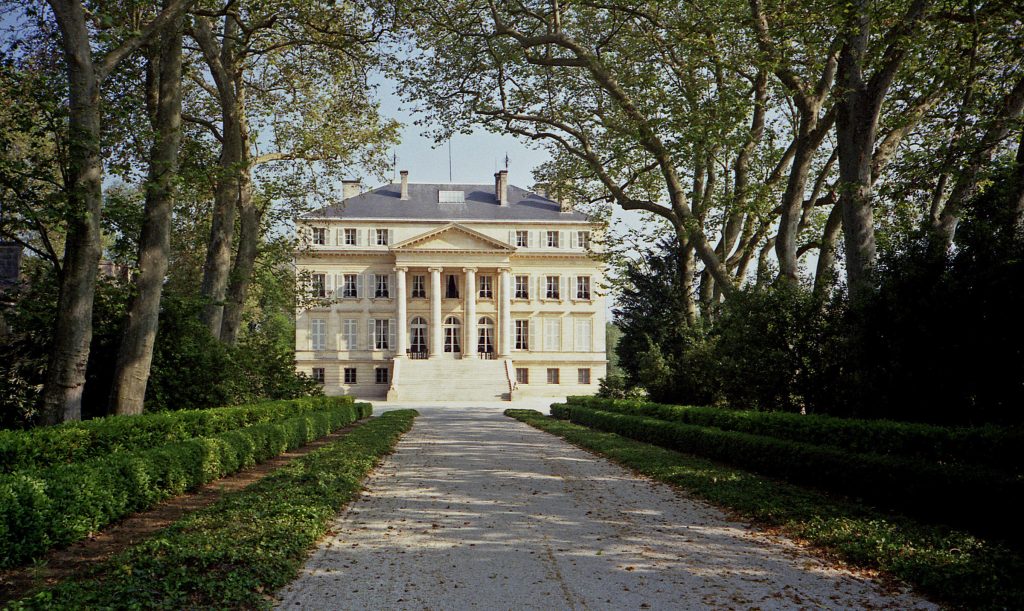Margaux 2023: an impressive vintage in a tough year
Last year I started my journey through the Médoc in the North; this year I start in the South in its largest appellation, by both surface area and by the number of separate properties, Margaux.

As in 2022, though for rather different reasons, Margaux did not have it easy in 2023.
More than any other leading left-bank appellation it suffered from the absence of winter rainfall, with the vines in effect experiencing a continuation of the hydric deficit of 2022 (a year which saw 12 per cent less rainfall than the 10 year average). It then saw less rainfall between budburst and the harvest than every other left-bank appellation save St-Estèphe, belying a little the idea that total rainfall accumulations increased during the year as one descended the Gironde. Unremarkably, then, and as Table 1 shows in more detail, it saw less rainfall over the entire year than every other left-bank appellation including Pessac-Léognan.
|
Pre-budburst (Nov-March) |
Budburst to Harvest (April-mid October) |
Total (1/11-15/10) |
|
| Margaux | 398 (-19.3%) | 464.6 (+11.0%) | 862.6 (-5.7%) |
| St Julien | 458 (-5.8%) | 441.3 (+13.3%) | 899.2 (+1.2%) |
| Pauillac | 458 (-5.8%) | 441.3 (+13.2%) | 899.2 (+1.2%) |
| St-Estèphe | 550.7 (+3.0%) | 411.8 (+4.7%) | 912.5 (+1.5%) |
| Pessac-Léognan | 426 (-12.4%) | 469.4 (+14.5%) | 895.2 (0%) |
| St-Emilion | 306 (-37.1%) | 490.8 (+18.1%) | 796.8 (-11.8%) |
| Pomerol | 338 (-31.5%) | 470.0 (+14.5%) | 808.1 (-10.9%) |
Table 1: Rainfall during the vintage (relative to 10-year average)
Source: calculated from Saturnalia’s Bordeaux 2023 Harvest report
In a year of significant, intense and in some cases unprecedented mildew pressure that might seem like a good thing. But Margaux certainly got its fair share of the June rainfall that was the immediate precursor and catalyst of the mildew contagion. That rainfall came in the form of a series of intense downpours invariably preceded and immediately followed by spikes in temperature.
The combination was potentially devastating, above all on the Merlot plots more characteristic of the appellation. A further exacerbating factor is that, of all Médocain appellations, Margaux has the highest proportion of vineyards practicing organic and/or biodynamic viticulture. Suffice it to note that, restricted as such producers are to the repeated use of the contact treatment la bouillie Bordelaise, the now familiar fight against mildew is never as effective in such vineyards as for those able to deploy more conventional treatments.
The long and the short of it is that Margaux suffered significantly more mildew damage than any other leading appellation. And parcels already weakened by exposure to mildew in June were also more likely to suffer desiccation and burning of the fruit on the vines in the unprecedented Indian summer heatwave conditions of the second half of August and early September. Some properties, including at least a couple of classed growths, lost a quarter of their potential yield in this way.
The results are clear to see from the average appellation vineyard yields presented in Table 2. With the exception of 2022, Margaux average yields are the lowest since 2018. In stark contrast, those in St Julien and St-Estèphe are the highest in 15 years.
That is bad enough already. But what these aggregate data also fail to show is the great vineyard-to-vineyard variation, with neighbouring properties on ostensibly similar terroirs often varying in their average yields by a staggering 20 hl/ha. Some properties achieved final yields exceeding 50 hl/ha, many others struggled to get into the low twenties.
| 2019 | 2020 | 2021 | 2022 | 2023 | 10-year average | Relative to 10-year average (% change) | |
| Margaux | 49.2 | 36.3 | 38.6 | 31.3 | 37.7 | 39.7 | -5.0 |
| St Julien | 45.5 | 34.3 | 35.2 | 34.3 | 50.3 | 40.1 | +25.4 |
| Pauillac | 46.7 | 37.4 | 35.1 | 34.8 | 47.1 | 39.7 | +18.6 |
| St Estèphe | 49.7 | 41.2 | 40.7 | 31.5 | 51.6 | 43.4 | +18.9 |
| Pessac-Léognan rouge | 47.2 | 34.6 | 30.7 | 35.7 | 38.1 | 38.5 | -1.0 |
| St Emilion (GC) | 43.0 | 36.7 | 27.5 | 41.2 | 40.5 | 37.2 | +8.9 |
| Pomerol | 43.0 | 39.8 | 28.9 | 32.3 | 45.2 | 36.1 | +25.2 |
Table 2: Average vineyard yield by appellation (hl/ha)
Source: calculated from Duanes data compiled by the CIVB Service Economie et Etudes
What is clear from this is that, just as in 2022 if for very different reasons, Margaux suffered both the most significant fall in vineyard yields relative to the 10-year average (indeed, it was one of only two leading appellation to suffer a fall) and the lowest actual average yield of any of the leading appellations (at a somewhat depressing 37.7 hl/ha).
But that is not the headline news here – certainly for consumers (it is, of course, rather more important for producers since it is, in a sense, their bread and butter).
Partner Content
For however surprising though it might well seem given the above, the leading wines of Margaux are the qualitative equivalent of the very best that the Médoc has to offer in this vintage. They are far from homogeneous but that is no less true of the peers throughout the region (with the partial exception of St-Estèphe).
More positively still, this is a vintage that, at its best, flatters the ‘new classicism’ (as I have referred to it before) that Margaux, above all, has sought to cultivate in recent years. These wines are lithe, supple, fine, elegant and highly aromatic; these are also highly expressive of the terroirs from which they hail.
Overall, then, the results are impressive in any context, all the more so when the difficulties of the vintage above all in Margaux are taken into account.
Who stood out?
Margaux is, as it so invariably is, the star of the show – a clear potential candidate for the wine of the entire left-bank (since I have yet to review the other appellations I will try not to reveal too much at this stage, but the competition is intense). It is a sublimely graceful and elegant wine than is more than ever expressive of the appellation with which it shares its name.
Very close behind, and in something of a tie for second place, if very different in their distinct personalities, are a radiant and exuberant Brane-Cantenac and a more shimmering and glistening Palmer. What they share is the sheer quality of their tannins, all the more impressive given their mid-palate density and concentration.
Gonzague Lurton and his colleagues at Durfort-Vivens have triumphed once again in producing a wine of ethereal beauty and supreme aromatic florality that elevates as it respects and honours this exceptional terroir.
Despite the difficulties of coping with the challenges of mildew whilst in transition to organic viticulture, Rauzan-Ségla has made the latest in a series of exemplary wines that have helped to restore the very identity of the appellation. In 2023 it is a study in the quality of Margaux Cabernet Sauvignon and it is highly recommended.
In terms of sheer value I would also like to single out three wines that I have underscored before: Desmirail, Ferrière and Siran – and one that I am doing so in this way for the first time, having admired it from the first vintage I tasted, Moutte Blanc. Each is likely to represent outstanding quality for the price demanded in a part of the Bordeaux market place that is intensely price competitive – and that is only likely to become more so with this campaign.
I could go on, as familiar readers of this column know all too well. But let me conclude, simply and briefly, just by drawing your attention to two wines that, in their different ways, I find particularly note-worthy in this vintage.
The first is Cantenac Brown, perhaps the wine that has improved the most within the appellation in recent vintages and that now challenges very seriously for a place in the top 5 wines of Margaux.
The second is Lascombes, and it is fitting I think that my profile of the appellation should conclude here. It is perhaps the single left-bank wine that I was most intrigued to taste. This is Axel Heinz’s first full vintage at the helm of this (frankly) long-languishing (if still much admired) second growth. It is a wine, to be fair, that I have always loved but which has never perhaps quite attained a level consistent with the quality of its terroir (or at least the best of its terroir). That has changed. In 2023 it has produced a statement wine that will become the new reference point for the property. The transformation is as instantaneous as it is startling.
Highlights in 2022
Best of the appellation:
- Margaux (97-99)
Truly great:
- Brane Cantenac (96-98)
- Palmer (96-98)
- Durfort-Vivens (95-97+)
- Rauzan-Ségla (95-97)
- Lascombes (94-96+)
- Cantenac Brown (94-96)
- Giscours (94-96)
- D’Issan (94-96)
Value picks:
- Ferrière (92-94)
- Cantenac Brown (94-96)
- Desmirail (92-94)
- Marquis d’Alesme (92-94)
- Marquis de Terme (92-94)
- Moutte Blanc (92-94)
- Siran (92-94)
- Du Tertre (92-94)
See here for Colin’s full tasting notes
Read more:
A guide to Bordeaux 2023 in ten questions
Bordeaux 2023 vintage report part I: quality and quantity together, for once
Bordeaux vintage report part 2: a vintage of reactivity, vigilance and surveillance
Related news
Castel Group leadership coup escalates
For the twelfth day of Christmas...
Zuccardi Valle de Uco: textured, unique and revolutionary wines




